Thermodynamic Analyses of Sub- and Supercritical ORCs Using R1234yf, R236ea and Their Mixtures as Working Fluids for Geothermal Power Generation
Abstract
:1. Introduction
2. Methodology
2.1. System Description
2.2. Thermodynamic Model
2.3. Determination of Pinch Point
2.3.1. Evaporation Process
2.3.2. Condensation Process
2.4. Boundary Conditions and Parameter Optimization
3. Results and Discussion
3.1. Parametric Optimization
3.1.1. Evaporation Pressure
3.1.2. Turbine Inlet Temperature
3.2. Net Power Output
3.3. Exergy Analysis
3.4. Effect of IHE
3.5. Exergy Efficiency
4. Conclusions
Author Contributions
Funding
Institutional Review Board Statement
Informed Consent Statement
Data Availability Statement
Conflicts of Interest
References
- Jain, C.; Christian, V.; Clauser, C. Maximum potential for geothermal power in Germany based on engineered geothermal systems. Geotherm. Energy 2015, 3, 15. [Google Scholar] [CrossRef] [Green Version]
- Balat, M.; Balat, H.; Faiz, U. Utilization of Geothermal Energy for Sustainable Global Development. Energy Sources Part B Econ. Plan. Policy 2009, 4, 295–309. [Google Scholar] [CrossRef]
- Anderson, A.; Rezaie, B. Geothermal technology: Trends and potential role in a sustainable future. Appl. Energy 2019, 248, 18–34. [Google Scholar] [CrossRef]
- Dipippo, R. Second law assessment of binary plants generating power from low-temperature geothermal fluids. Geothermics 2004, 33, 565–586. [Google Scholar] [CrossRef] [Green Version]
- Hu, S.; Yang, Z.; Li, J.; Duan, Y. A Review of Multi-Objective Optimization in Organic Rankine Cycle (ORC) System Design. Energies 2021, 14, 6492. [Google Scholar] [CrossRef]
- Luo, X.L.; Wang, Y.P.; Liang, J.W.; Qi, J.; Su, W.; Yang, Z.; Chen, J.W.; Wang, C.; Chen, Y. Improved correlations for working fluid properties prediction and their application in performance evaluation of sub-critical Organic Rankine Cycle. Energy 2019, 174, 122–137. [Google Scholar] [CrossRef]
- Wang, S.K.; Liu, C.; Li, Q.B.; Liu, L.; Huo, E.G.; Zhang, C. Selection principle of working fluid for organic Rankine cycle based on environmental benefits and economic performance. Appl. Therm. Eng. 2020, 178, 115598. [Google Scholar] [CrossRef]
- Wang, Z.J.; Tian, H.; Shi, L.F.; Shu, G.Q.; Kong, X.H.; Li, L.G. Fluid Selection of Transcritical Rankine Cycle for Engine Waste Heat Recovery Based on Temperature Match Method. Energies 2020, 13, 1830. [Google Scholar] [CrossRef] [Green Version]
- Xu, W.C.; Deng, S.; Su, W.; Zhang, Y.; Zhao, L.; Yu, Z.X. How to approach Carnot cycle via zeotropic working fluid: Research methodology and case study. Energy 2018, 144, 576–586. [Google Scholar] [CrossRef]
- Heberle, F.; Brüeggemann, D. Thermo-Economic Analysis of Zeotropic Mixtures and Pure Working Fluids in Organic Rankine Cycles for Waste Heat Recovery. Energies 2016, 9, 226. [Google Scholar] [CrossRef] [Green Version]
- Heberle, F.; Brüeggemann, D. Thermo-Economic Evaluation of Organic Rankine Cycles for Geothermal Power Generation Using Zeotropic Mixtures. Energies 2015, 8, 2097–2124. [Google Scholar] [CrossRef] [Green Version]
- Lecompte, S.; Ameel, B.; Ziviani, D.; van den Broek, M.; De Paepe, M. Exergy analysis of zeotropic mixtures as working fluids in Organic Rankine Cycles. Energy Convers. Manag. 2014, 85, 727–739. [Google Scholar] [CrossRef]
- Liu, Q.; Shen, A.J.; Duan, Y.Y. Parametric optimization and performance analyses of geothermal organic Rankine cycles using R600a/R601a mixtures as working fluids. Appl. Energy 2015, 148, 410–420. [Google Scholar] [CrossRef]
- Liu, Q.; Duan, Y.Y.; Yang, Z. Effect of condensation temperature glide on the performance of organic Rankine cycles with zeotropic mixture working fluids. Appl. Energy 2014, 115, 394–404. [Google Scholar] [CrossRef]
- Chys, M.; Van Den Broek, M.; Vanslambrouck, B.; De Paepe, M. Potential of zeotropic mixtures as working fluids in organic Rankine cycles. Energy 2012, 44, 623–632. [Google Scholar] [CrossRef]
- Wang, S.; Zhang, W.; Feng, Y.Q.; Wang, X.; Wang, Q.; Liu, Y.Z.; Wang, Y.; Yao, L. Entropy, Entransy and Exergy Analysis of a Dual-Loop Organic Rankine Cycle (DORC) Using Mixture Working Fluids for Engine Waste Heat Recovery. Energies 2020, 13, 1301. [Google Scholar] [CrossRef] [Green Version]
- Feng, Y.Q.; Hung, T.C.; He, Y.L.; Wang, Q.; Wang, S.; Li, B.X.; Lin, J.R.; Zhang, W.P. Operation characteristic and performance comparison of organic Rankine cycle (ORC) for low-grade waste heat using R245fa, R123 and their mixtures. Energy Convers. Manag. 2017, 144, 153–163. [Google Scholar] [CrossRef]
- Chen, H.J.; Goswami, D.Y.; Stefanakos, E.K. A review of thermodynamic cycles and working fluids for the conversion of low-grade heat. Renew. Sust. Energ. Rev. 2010, 14, 3059–3067. [Google Scholar] [CrossRef]
- Xu, W.C.; Deng, S.; Zhao, L.; Su, W.; Zhang, Y.; Li, S.J.; Ma, M.L. How to quantitatively describe the role of the pure working fluids in subcritical organic Rankine cycle: A limitation on efficiency. Energy Convers. Manag. 2018, 172, 316–327. [Google Scholar] [CrossRef]
- Shi, L.F.; Shu, G.Q.; Tian, H.; Deng, S. A review of modified Organic Rankine cycles (ORCs) for internal combustion engine waste heat recovery (ICE-WHR). Renew. Sust. Energ. Rev. 2018, 92, 95–110. [Google Scholar] [CrossRef]
- Oyewunmi, O.A.; Kirmse, C.J.W.; Pantaleo, A.M.; Markides, C.N. Performance of working-fluid mixtures in ORC-CHP systems for different heat-demand segments and heat-recovery temperature levels. Energy Convers. Manag. 2017, 148, 1508–1524. [Google Scholar] [CrossRef]
- Quoilin, S.; Van den Broek, M.; Declaye, S.; Dewallef, P.; Lemort, V. Techno-economic survey of Organic Rankine Cycle (ORC) systems. Renew. Sust. Energ. Rev. 2013, 22, 168–186. [Google Scholar] [CrossRef] [Green Version]
- Miao, Z.; Zhang, K.; Wang, M.X.; Xu, J.L. Thermodynamic selection criteria of zeotropic mixtures for subcritical organic Rankine cycle. Energy 2019, 167, 484–497. [Google Scholar] [CrossRef]
- Yang, F.F.; Yang, F.B.; Chu, Q.F.; Liu, Q.; Yang, Z.; Duan, Y.Y. Thermodynamic performance limits of the organic Rankine cycle: Working fluid parameterization based on corresponding states modeling. Energy Convers. Manag. 2020, 217, 113011. [Google Scholar] [CrossRef]
- Braimakis, K.; Mikelis, A.; Charalampidis, A.; Charalampidis, A.; Karellas, S. Exergetic performance of CO2 and ultra-low GWP refrigerant mixtures as working fluids in ORC for waste heat recovery. Energy 2020, 203, 117801. [Google Scholar] [CrossRef]
- Dong, B.S.; Xu, G.Q.; Li, T.T.; Quan, Y.K.; Wen, J. Thermodynamic and economic analysis of zeotropic mixtures as working fluids in low temperature organic Rankine cycles. Appl. Therm. Eng. 2018, 132, 545–553. [Google Scholar] [CrossRef]
- Su, W.; Hwang, Y.H.; Deng, S.; Zhao, L.; Zhao, D.P. Thermodynamic performance comparison of Organic Rankine Cycle between zeotropic mixtures and pure fluids under open heat source. Energy Convers. Manag. 2018, 165, 720–737. [Google Scholar] [CrossRef]
- Xi, H.; Li, M.J.; He, Y.L.; Zhang, Y.W. Economical evaluation and optimization of organic Rankine cycle with mixture working fluids using R245fa as flame retardant. Appl. Therm. Eng. 2017, 113, 1056–1070. [Google Scholar] [CrossRef]
- Feng, Y.Q.; Luo, Q.H.; Wang, Q.; Wang, S.; He, Z.X.; Zhang, W.; Wang, X.; An, Q.S. Entropy and Entransy Dissipation Analysis of a Basic Organic Rankine Cycles (ORCs) to Recover Low-Grade Waste Heat Using Mixture Working Fluids. Entropy 2018, 20, 818. [Google Scholar] [CrossRef] [PubMed]
- Feng, Y.Q.; Hung, T.C.; Greg, K.; Zhang, Y.N.; Li, B.X.; Yang, J.F. Thermoeconomic comparison between pure and mixture working fluids of organic Rankine cycles (ORCs) for low temperature waste heat recovery. Energy Convers. Manag. 2015, 106, 859–872. [Google Scholar] [CrossRef]
- Zhai, H.X.; An, Q.S.; Shi, L. Zeotropic mixture active design method for organic Rankine cycle. Appl. Therm. Eng. 2018, 129, 1171–1180. [Google Scholar] [CrossRef]
- Lecompte, S.; Huisseune, H.; Van Den Broek, M.; Vanslambrouck, B.; De Paepe, M. Review of organic Rankine cycle (ORC) architectures for waste heat recovery. Renew. Sust. Energ. Rev. 2015, 47, 448–461. [Google Scholar] [CrossRef]
- Chen, H.J.; Goswami, D.Y.; Rahman, M.M.; Stefanakos, E.K. A supercritical Rankine cycle using zeotropic mixture working fluids for the conversion of low-grade heat into power. Energy 2011, 36, 549–555. [Google Scholar] [CrossRef]
- Zhang, X.X.; Zhang, Y.; Cao, M.; Wang, J.F.; Wu, Y.T.; Ma, C.F. Working Fluid Selection for Organic Rankine Cycle Using Single-Screw Expander. Energies 2019, 12, 3197. [Google Scholar] [CrossRef] [Green Version]
- Zhang, X.X.; Zhang, Y.; Li, Z.L.; Wang, J.F.; Wu, Y.T.; Ma, C.F. Zeotropic Mixture Selection for an Organic Rankine Cycle Using a Single Screw Expander. Energies 2020, 13, 1022. [Google Scholar] [CrossRef] [Green Version]
- Wang, X.C.; Levy, E.K.; Pan, C.J.; Romero, C.E.; Banerjee, A.; Rubio-Maya, C.; Pan, L.H. Working fluid selection for organic Rankine cycle power generation using hot produced supercritical CO2 from a geothermal reservoir. Appl. Therm. Eng. 2019, 149, 1287–1304. [Google Scholar] [CrossRef]
- Meng, N.; Li, T.L.; Jia, Y.A.; Qin, H.S.; Liu, Q.H.; Zhao, W.Q.; Lei, G.B. Techno-economic performance comparison of enhanced geothermal system with typical cycle configurations for combined heating and power. Energy Convers. Manag. 2020, 205, 112409. [Google Scholar] [CrossRef]
- Zhang, C.; Liu, C.; Xu, X.X.; Li, Q.B.; Wang, S.K.; Chen, X. Effects of superheat and internal heat exchanger on thermo-economic performance of organic Rankine cycle based on fluid type and heat sources. Energy 2018, 159, 482–495. [Google Scholar] [CrossRef]
- Saleh, B.; Koglbauer, G.; Wendland, M.; Fischer, J. Working fluids for low-temperature organic Rankine cycles. Energy 2007, 32, 1210–1221. [Google Scholar] [CrossRef]
- Li, S.; Dai, Y.P. Thermo-Economic Analysis of Waste Heat Recovery ORC Using Zeotropic Mixtures. J. Energy Eng. 2015, 141, 4014050. [Google Scholar] [CrossRef]
- Fang, Y.W.; Yang, F.B.; Zhang, H.G. Comparative analysis and multi-objective optimization of organic Rankine cycle (ORC) using pure working fluids and their zeotropic mixtures for diesel engine waste heat recovery. Appl. Therm. Eng. 2019, 157, 113704. [Google Scholar] [CrossRef]
- Li, C.Y.; Wang, H.X. Power cycles for waste heat recovery from medium to high temperature flue gas sources—From a view of thermodynamic optimization. Appl. Energy 2016, 180, 707–721. [Google Scholar] [CrossRef]
- Song, C.Z.; Gu, M.Y.; Miao, Z.; Liu, C.; Xu, J.L. Effect of fluid dryness and critical temperature on trans-critical organic Rankine cycle. Energy 2019, 174, 97–109. [Google Scholar] [CrossRef]
- Invernizzi, C.M.; Ayub, A.; Di Marcoberardino, G.; Lora, P. Pure and Hydrocarbon Binary Mixtures as Possible Alternatives Working Fluids to the Usual Organic Rankine Cycles Biomass Conversion Systems. Energies 2019, 12, 4140. [Google Scholar] [CrossRef] [Green Version]
- Zhang, C.; Fu, J.L.; Yuan, P.F.; Liu, J.J. Guidelines for Optimal Selection of Subcritical Low-Temperature Geothermal Organic Rankine Cycle Configuration Considering Reinjection Temperature Limits. Energies 2018, 11, 2878. [Google Scholar] [CrossRef] [Green Version]
- Chen, Q.C.; Xu, J.L.; Chen, H.X. A new design method for Organic Rankine Cycles with constraint of inlet and outlet heat carrier fluid temperatures coupling with the heat source. Appl. Energy 2012, 98, 562–573. [Google Scholar] [CrossRef]
- Oyewunmi, O.A.; Ferre-Serres, S.; Lecompte, S.; van den Broek, M.; de Paepe, M.; Markides, C.N. An assessment of subcritical and trans-critical organic Rankine cycles for waste-heat recovery. Energy Procedia 2017, 105, 1870–1876. [Google Scholar] [CrossRef]
- Invernizzi, C.; Bombarda, P. Thermodynamic performance of selected HCFS for geothermal applications. Energy 1997, 22, 887–895. [Google Scholar] [CrossRef]
- Feng, Y.Q.; Hung, T.C.; Wu, S.L.; Lin, C.H.; Li, B.X.; Huang, K.C.; Qin, J. Operation characteristic of a R123-based organic Rankine cycle depending on working fluid mass flow rates and heat source temperatures. Energy Convers. Manag. 2017, 131, 55–68. [Google Scholar] [CrossRef]
- Heberle, F.; Preißinger, M.; Brüeggemann, D. Zeotropic mixtures as working fluids in Organic Rankine Cycles for low-enthalpy geothermal resources. Renew. Energy 2012, 37, 364–370. [Google Scholar] [CrossRef]
- Pan, L.S.; Shi, W.X. Investigation on the Pinch Point Position in Heat Exchangers. J. Therm. Sci. 2016, 25, 258–265. [Google Scholar] [CrossRef] [Green Version]
- Sun, J.; Liu, Q.; Duan, Y.Y. Effects of evaporator pinch point temperature difference on thermo-economic performance of geothermal organic Rankine cycle systems. Geothermics 2018, 75, 249–258. [Google Scholar] [CrossRef]
- Meng, D.Y.; Liu, Q.; Ji, Z.L. Performance analyses of regenerative organic flash cycles for geothermal power generation. Energy Convers. Manag. 2020, 224, 113396. [Google Scholar] [CrossRef]

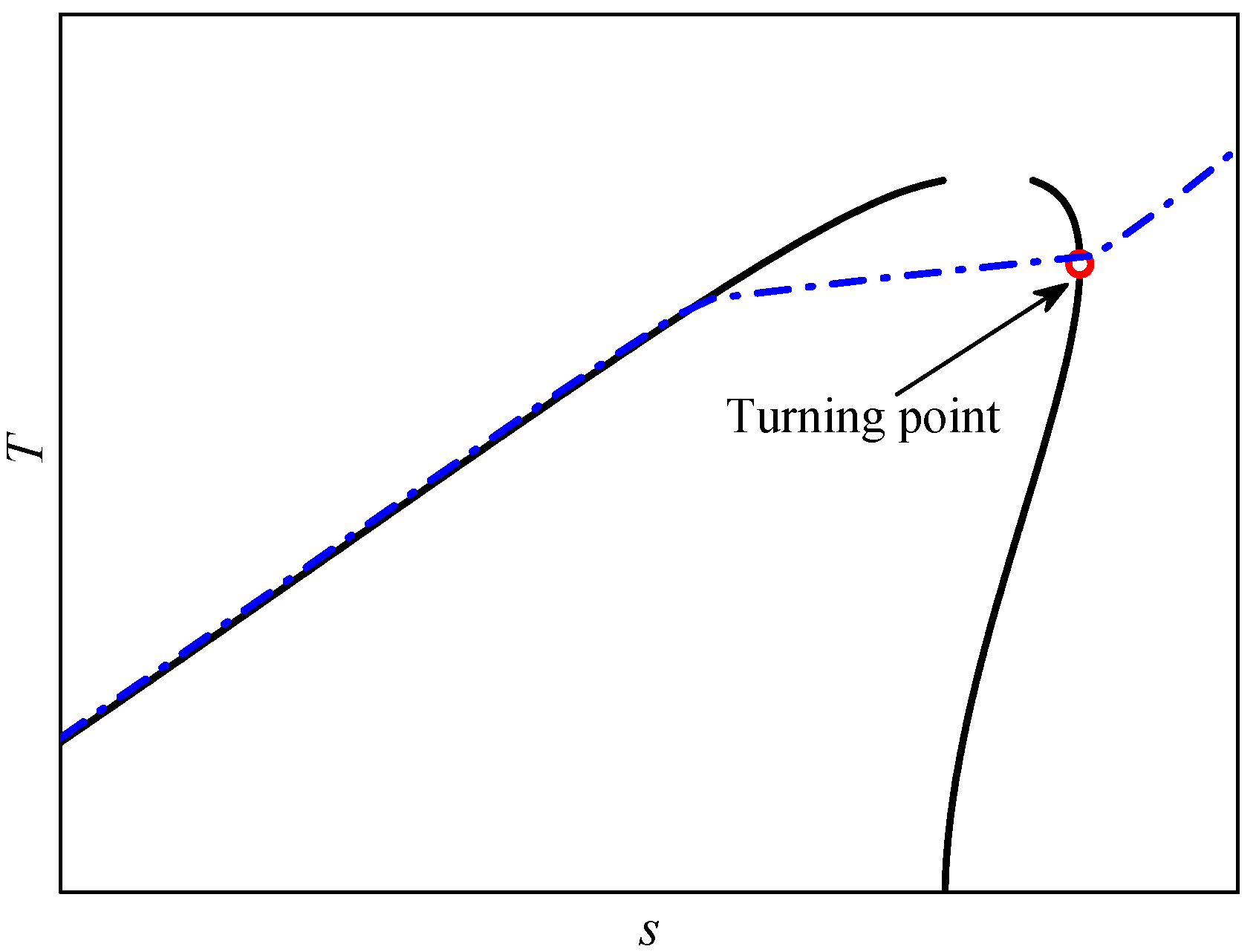







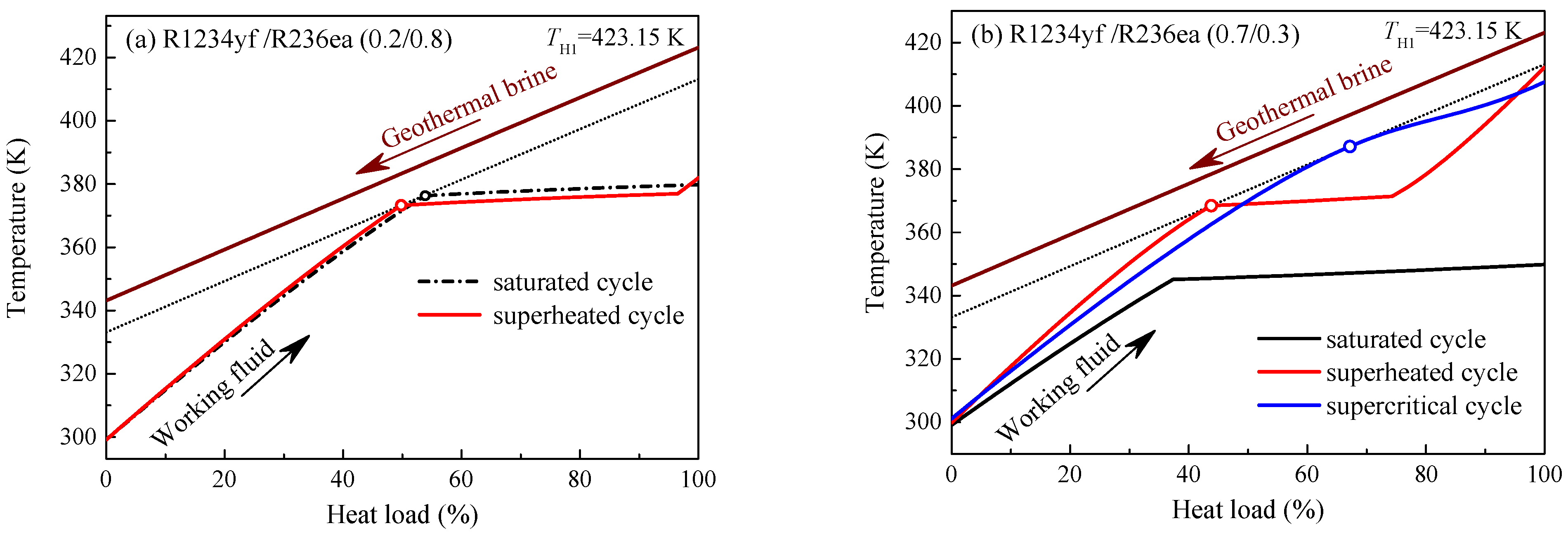




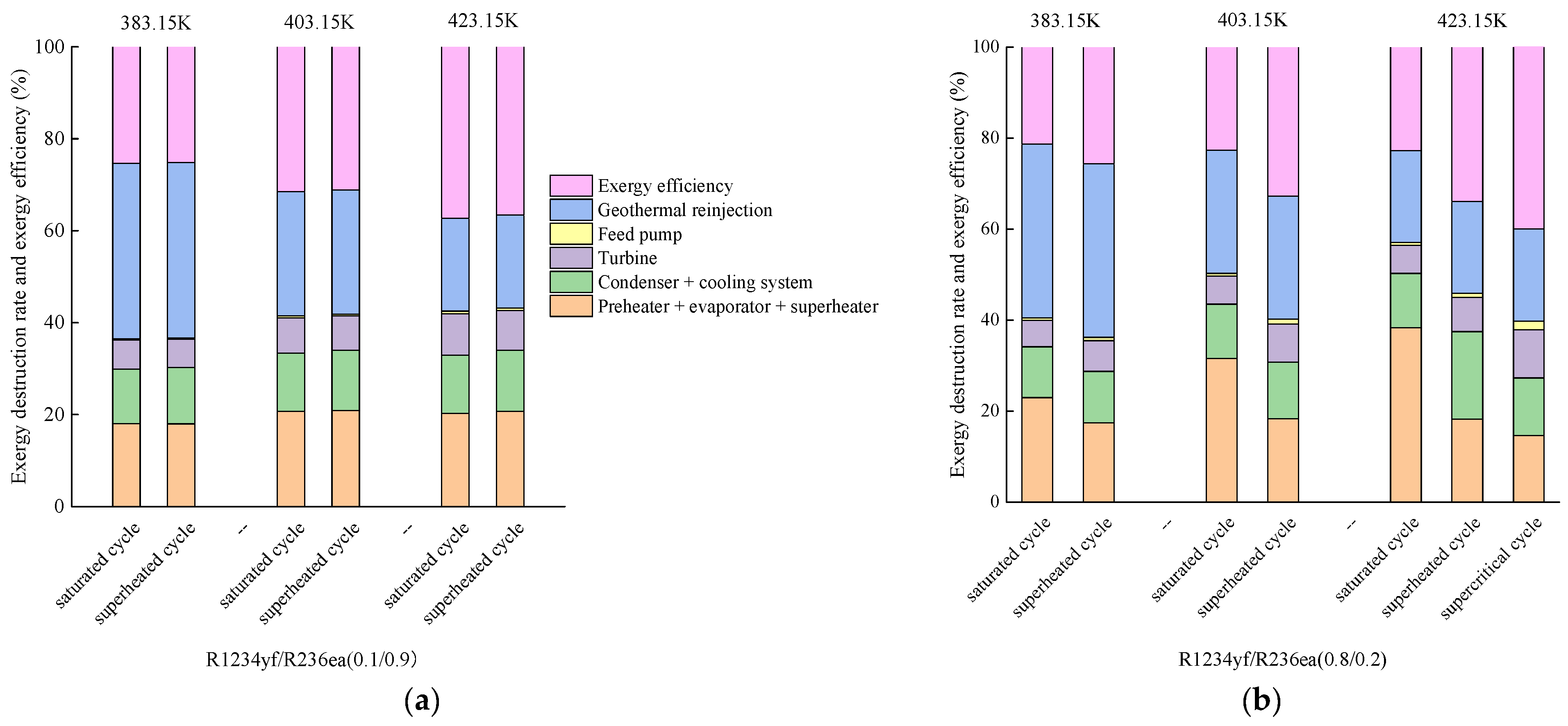

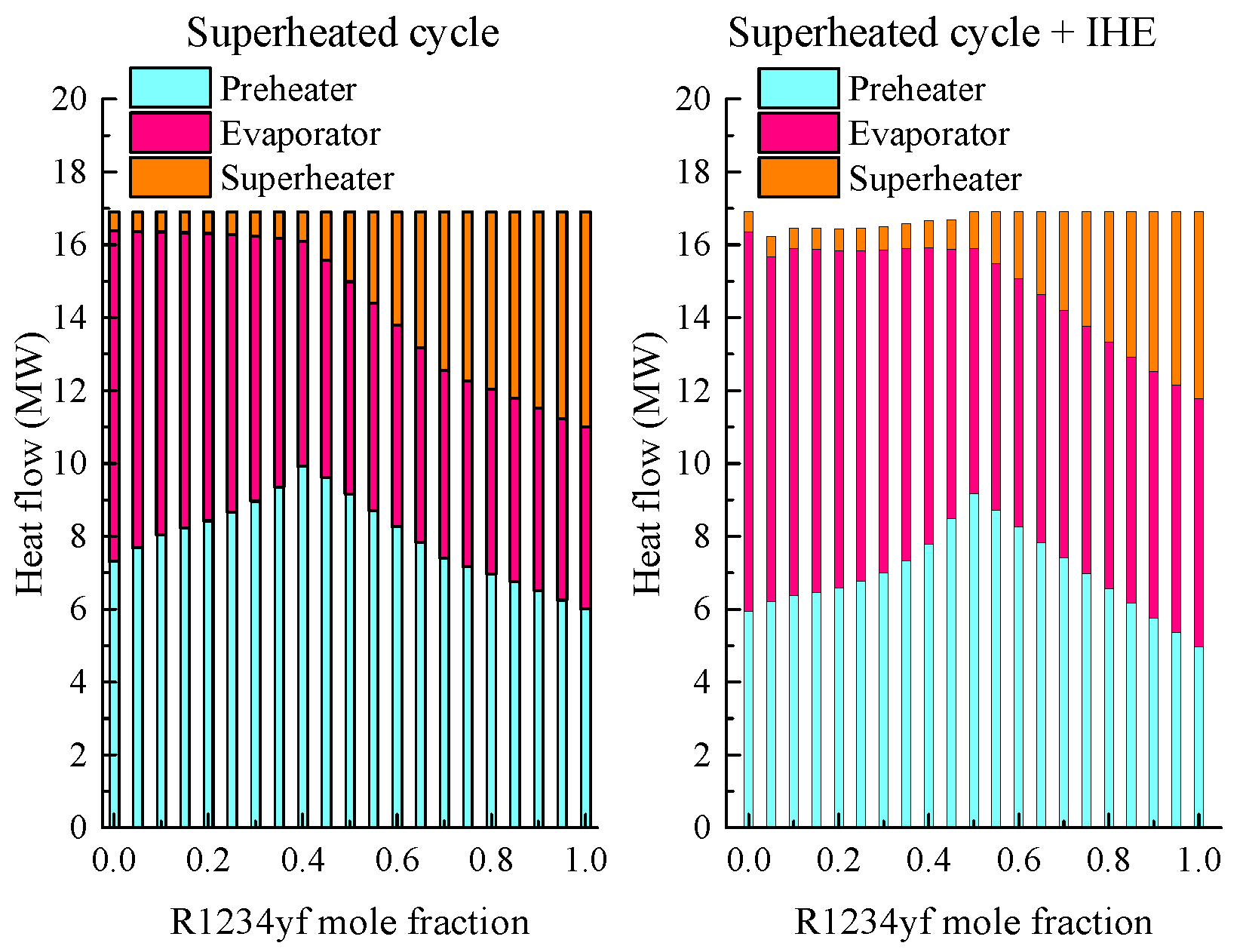


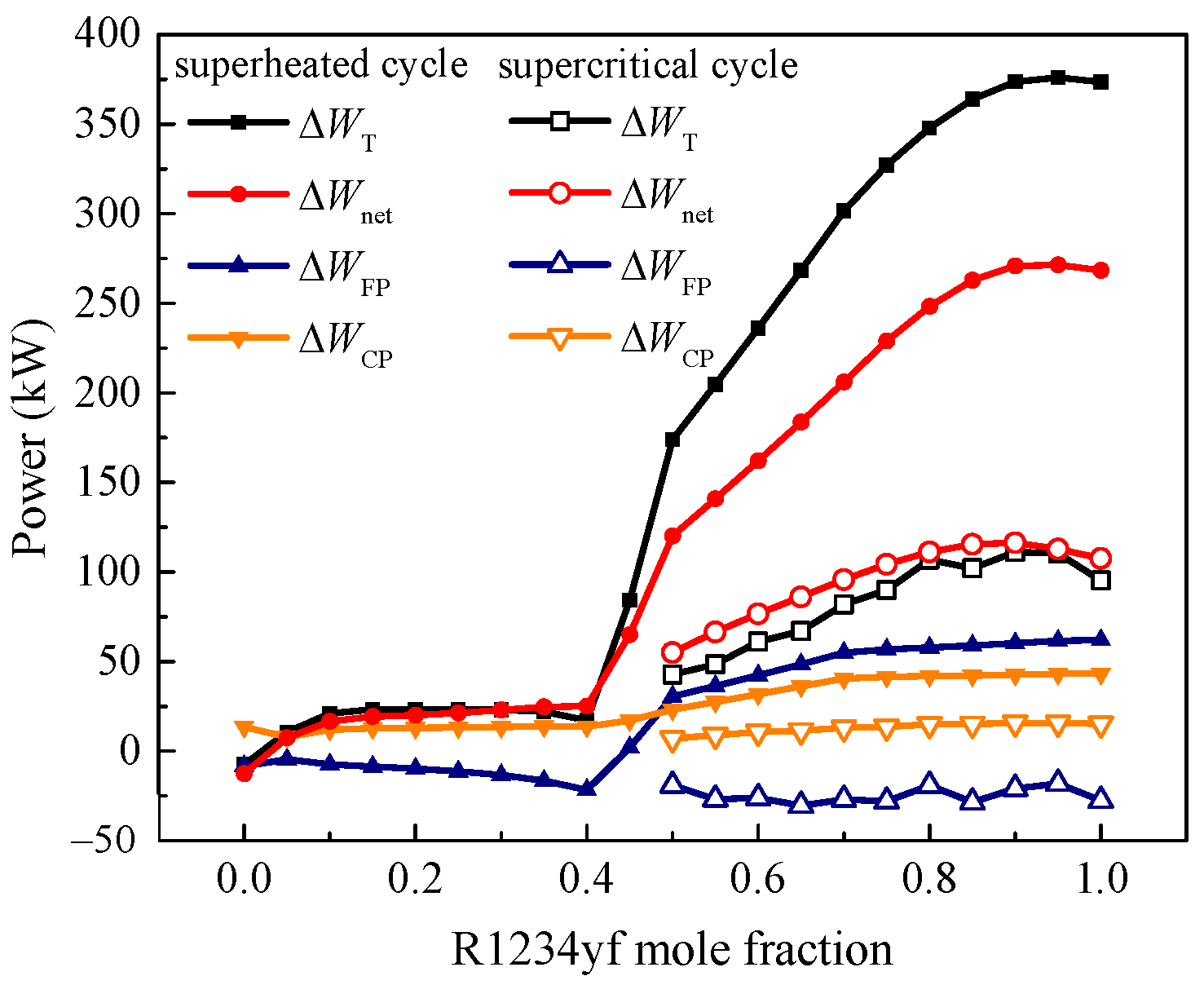

| Parameter | Value |
|---|---|
| Geothermal brine temperature (K) | 423.15, 403.15, 383.15 |
| Geothermal brine reinjection temperature (K) | ≥343.15 |
| Geothermal water pressure (kPa) | 4000 |
| Geothermal water mass flow (kg/s) | 50 |
| Evaporator pinch-point temperature difference (K) | 10 |
| Condenser pinch-point temperature difference (K) | 5 |
| IHE pinch-point temperature difference (K) | 10 |
| Cooling water inlet temperature (K) | 293.15 |
| Circulating pump head (m) | 20 |
| Circulating pump efficiency | 0.8 |
| Turbine efficiency | 0.85 |
| Pump isentropic efficiency | 0.75 |
| Turbine mechanical efficiency | 0.98 |
| Generating efficiency | 0.98 |
Disclaimer/Publisher’s Note: The statements, opinions and data contained in all publications are solely those of the individual author(s) and contributor(s) and not of MDPI and/or the editor(s). MDPI and/or the editor(s) disclaim responsibility for any injury to people or property resulting from any ideas, methods, instructions or products referred to in the content. |
© 2023 by the authors. Licensee MDPI, Basel, Switzerland. This article is an open access article distributed under the terms and conditions of the Creative Commons Attribution (CC BY) license (https://creativecommons.org/licenses/by/4.0/).
Share and Cite
Liu, Q.; Chen, R.; Yang, X.; Xiao, X. Thermodynamic Analyses of Sub- and Supercritical ORCs Using R1234yf, R236ea and Their Mixtures as Working Fluids for Geothermal Power Generation. Energies 2023, 16, 5676. https://doi.org/10.3390/en16155676
Liu Q, Chen R, Yang X, Xiao X. Thermodynamic Analyses of Sub- and Supercritical ORCs Using R1234yf, R236ea and Their Mixtures as Working Fluids for Geothermal Power Generation. Energies. 2023; 16(15):5676. https://doi.org/10.3390/en16155676
Chicago/Turabian StyleLiu, Qiang, Ran Chen, Xinliu Yang, and Xiao Xiao. 2023. "Thermodynamic Analyses of Sub- and Supercritical ORCs Using R1234yf, R236ea and Their Mixtures as Working Fluids for Geothermal Power Generation" Energies 16, no. 15: 5676. https://doi.org/10.3390/en16155676





